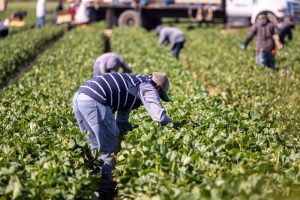With weather warming up and frost advisories fading into the distance, we’re entering peak growing season in the agricultural sector. These crucial months mean the bulk of revenue for farmers, but they bring with them a host of workplace safety issues. Now is the time to invest in both training and ergonomic monitoring measures to safeguard agricultural workers and enhance productivity.
Understanding safety issues in agriculture (and their consequences)
Farm work is dangerous work, and it’s dangerous for a host of reasons. Studies have revealed that the agricultural sector is the deadliest in America, with fatality rates greatly outpacing many other industries.
In addressing the common risks within this sector, it’s crucial to recognize the marginalized demographics disproportionately affected. A significant portion of the industry comprises migrant workers who encounter systemic challenges concerning healthcare access and preventative safety measures. Compounded by language barriers, insufficient training, and inadequate identification of underlying health concerns, farm workers face, in many cases, heightened vulnerability to workplace injuries and fatalities.
Agricultural workers face unique risks due to the nature of their tasks. Equipment failures, such as tractor malfunctions or machinery breakdowns, can lead to serious accidents. Vehicle-related incidents, including rollovers and collisions, are also significant contributors to injuries and fatalities within the industry.
What’s more, long hours of operation and physically demanding tasks can contribute to fatigue, increasing the likelihood of accidents caused by diminished alertness and slower reaction times. These environmental concerns are even more devastating given that some of the most fertile growing areas of the country are in warm climates, and annual temperatures have steadily increased on average year over year.
Essentially, agricultural workers are highly vulnerable and work in dangerous conditions. The consequences of these conditions can be fatal for workers but can also mean massive fines for agribusinesses who operate unsafe workplaces.
Tailored safety through ergonomic monitoring
Given the risks associated with agricultural work, and the consequences when something goes wrong, it’s never been more essential to take safety seriously. Regular, focused training on safety procedures and proper use of equipment can help instill a sense of responsibility in farm workers, particularly those who work with minimal supervision.
Training can only get workers so far, however. With mandates to produce a certain amount of product, the pressure on workers can lead to overexertion, unsafe body movements, and ignoring warning signs that the worker may be at risk.
Thankfully, we exist in a moment where technological advancements have created ergonomic monitoring solutions that can track individual worker movements to reinforce safe activity while continuously monitoring key vital signs to avoid overexertion. What’s more, because ergonomic monitoring devices are individually deployed, they can be customized to the specific needs of the individual worker based on their role and physical attributes.
How to integrate ergonomic monitoring for maximum efficacy
Recent developments in wearables and IoT-connected devices have made it easier than ever to provide real-time monitoring of worker vital signs, posture, and exertion levels. By collecting and analyzing this data, employers can gain insights into each worker’s unique ergonomic requirements, allowing for the customization of safety protocols and task assignments.
Smart wearables equipped with biometric sensors can monitor everything from heart rate variability to physical exertion, body temperature, and more. Employers can compile this data and use it to optimize workloads and schedules, which helps ensure that workers do not exceed safe limits of physical exertion. Furthermore, motion-sensing technologies can detect poor posture or repetitive movements that may lead to musculoskeletal injuries.
When unsafe movements or dangerous exhaustion levels are detected, a worker can receive a notification to correct their posture or take a water break. And because this data is collected and analyzed by management, if there are repeated patterns of unsafe movements, it can be helpful for retraining.
Implementing these ergonomic monitoring devices can begin early on in an employee’s tenure, tied into the on-boarding process. By understanding a worker’s natural movements and physicality, wearables and connected devices can help not only assess risk but establish safe patterns that avoid musculoskeletal strain or overexertion from the very beginning.
The agricultural sector in the United States is crucial to feeding our population and countries beyond. Yet for how crucial this industry is, too many workers are left vulnerable and in unsafe working conditions. By closely monitoring worker health and movements, employers can promote a culture of safety that avoids overexertion and the types of workplace injuries which can have long-term, dramatic consequences.
As we enter the peak of the growing season, now is the time to implement these ergonomic monitoring measures to safeguard our most essential workers.
Adrian Rusu is Director, Head of Inteliforz Business Development EMEA and APAC.

